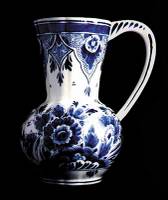Delft
I've always loved the game Scrabble. A few days ago while browsing Barnes and Noble, I stumbled across the book Word Freak, which chronicles the author's rise in the ranks of tournament Scrabble. Reading this book and seeing all the words that expert level players play, I feel as though I know nothing of the English language. Scores and scores of words exist that when you look at them, your first thought is, "Is that really a word?" Everytime a word is mentioned in this book that I've never seen before, I make a point to look its definition up. The fun part about this is that every time I look a new word up, I'm not just learning another word or an acceptable string of letters for Scrabble; I'm learning about a subject that I previously knew little or nothing about it. Take the word DELFT for example...
I had no idea that DELFT is a style of glazed earthenware, usually blue and white. Here's an example:

Below is an account of delft's history. (This is taken from the site of a company that makes this pottery. It's a Dutch company, evidenced by the poor English below).
And for good measure, here's a link to information about the city of Delft.
I've never really had an interest in pottery or earthenware (whatever you call it). In fact, I still don't. And the fact that it's Dutch makes it no more interesting. But learning anything is always fun...especially to trivia freaks like me.
I had no idea that DELFT is a style of glazed earthenware, usually blue and white. Here's an example:

Below is an account of delft's history. (This is taken from the site of a company that makes this pottery. It's a Dutch company, evidenced by the poor English below).
In the sixteenth century, in a number of Dutch towns, factories were established which among their items produced "Majolica". This "Majolica" was made with a tin-glaze and found its origins in Italy and Spain.
The Dutch East Indian Company began importing porcelain from China in the seventeenth century. This porcelain, especially the blue and white became very popular.
The "Majolica" producing factories started at a certain moment to imitate this Chinese porcelain, because of several reasons. The imported Chinese porcelain meant competition. Civil war in China made that imports from China went down. Customers asked for specific items which due to distance took a long time to deliver and due to language problems the delivered item was not always what was ordered.
In Delft, in the seventeenth century 32 factories were producing Delftware. One of them was a factory called "de Paauw". These factories were often established in beerbreweries which had stopped their production.
In the nineteenth century due to competition from other factories like Wedgewood in England and lack of innovations, the highlight of Delftware had come to a close. Nowadays in Delft only a few companies still produce the entirely handpainted traditional Delftware.
And for good measure, here's a link to information about the city of Delft.
I've never really had an interest in pottery or earthenware (whatever you call it). In fact, I still don't. And the fact that it's Dutch makes it no more interesting. But learning anything is always fun...especially to trivia freaks like me.

0 Comments:
Post a Comment
Subscribe to Post Comments [Atom]
<< Home